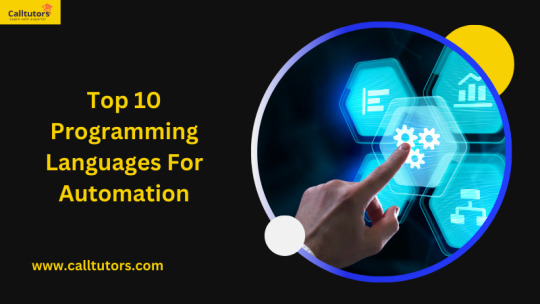Don't wanna be here? Send us removal request.
Text

Elevate your Minitab assignments with our top-notch support! ⭐️🚀
#assignmenthelp#homeworkhelper#minitabassignmenthelp#assignmenthelper#homeworkhelponline#onlinehelp#programminghelp#examhelp
0 notes
Text
Characteristics of Good Programming Language
Programming languages are very important for making software programs, operating systems, and other digital solutions in the world of technology, which is always changing. A good computer language is like a well-made tool that gives coders the power to make code that works well, is easy to manage, and can be scaled up or down. There are many programming languages, and each has its own pros and cons. However, there are some things that all good programming languages have in common. This blog post will talk about these traits and explain why they are necessary for making software development faster and better.
Note: If you are struggling with programming assignments, then you can get the best programming assignment help from our experts.
1. Simplicity and Readability
A good programming language should prioritize simplicity and readability. The syntax should be intuitive and easy to understand, allowing developers to write and comprehend code effortlessly. Simple and readable code not only enhances productivity but also facilitates collaboration within development teams. When code is readable, it becomes easier to maintain and modify, reducing the time and effort required for bug fixes and enhancements.
2. Expressiveness
Expressiveness refers to the ability of a programming language to convey complex ideas and concepts with concise and clear code. A good programming language should provide constructs and features that enable developers to express their ideas effectively, without the need for verbose or convoluted code. Expressive languages promote code clarity, making it easier to understand and reason about the program's behavior.
3. Portability and Platform Independence
In today's diverse computing landscape, a good programming language should be portable and platform-independent. This characteristic ensures that code written in the language can run seamlessly across different operating systems, architectures, and hardware configurations. Platform independence fosters code reusability and reduces the need for extensive modifications when deploying applications in different environments.
4. Scalability and Performance
As software projects grow in complexity and scope, a good programming language should offer scalability and performance capabilities. Scalability refers to the language's ability to handle large-scale applications and accommodate increasing workloads without compromising performance. Additionally, a good programming language should provide efficient execution, optimized memory management, and robust performance, ensuring that applications run smoothly and responsively.
5. Strong Typing and Type Safety
Type safety is a crucial feature of a good programming language. It ensures that data types are correctly defined and used throughout the code, preventing type-related errors and inconsistencies. Strong typing helps catch errors during compilation or interpretation, reducing the likelihood of runtime errors and improving code reliability.
6. Robust Error Handling and Debugging
Being able to handle errors and fix bugs effectively are important parts of a good computer language. The language should have ways to handle mistakes and exceptions, as well as ways to make testing easier. Strong error handling and testing tools help developers find and fix problems faster, which speeds up the development process and lowers the time it takes for apps to reach customers.
7. Extensive Library and Community Support
A thriving ecosystem of libraries, frameworks, and community support is a hallmark of a good programming language. Robust libraries and frameworks extend the language's functionality, enabling developers to leverage pre-built components and accelerate development cycles. Additionally, an active and supportive community contributes to knowledge sharing, problem-solving, and the continuous improvement of the language and its associated tools.
8. Modularity and Code Reusability
Modularity and being able to reuse code are important parts of a good computer language. The language should let you make flexible and reused pieces of code, which will help organize code, make it easier to manage, and make it work better. It's easier to understand, test, and change code that is organized in modules. This speeds up development and lowers technical debt.
9. Security and Reliability
In a world that is becoming more and more linked, security and dependability are the most important things for any good computer language. The language should include safe ways to code, like checking input, encrypting data, and controlling who can see it. Also, the language should put stability first, making sure that programs made with it are stable, can handle mistakes, and can keep running even when something goes wrong.
10. Continuous Evolution and Innovation
Lastly, a good computer language should be always changing to keep up with new technology and the needs of the business. Language creators and writers should keep working to make the language's features, speed, and usefulness better so that it stays useful and competitive in the world of software development, which is always changing.
Conclusion
In conclusion, the characteristics of a good programming language are multifaceted and encompass a wide range of factors that contribute to efficient and effective software development. From simplicity and readability to expressiveness and portability, a good programming language should empower developers to write clear, concise, and maintainable code. Additionally, scalability, performance, and type safety are crucial for building robust and reliable applications.
Robust error handling, extensive library support, and a thriving community are invaluable assets that enhance the language's usability and longevity. Modularity and code reusability promote code organization and efficiency, while security and reliability ensure that applications are secure and resilient.
0 notes
Text

Trying to understand the lesson like... 🧠💨
2 notes
·
View notes
Text
Top 10 Reasons Why Everyone Should Learn Python Programming
In the ever-evolving world of technology, coding has become an indispensable skill, and among the various programming languages, Python has emerged as a powerhouse. This versatile language has captured the attention of professionals and enthusiasts alike due to its simplicity, versatility, and widespread adoption. Whether you're a student, a professional, or someone looking to embark on a new career path, learning Python can open up a world of growth. In this blog post, we'll explore the top 10 reasons why everyone should consider learning Python programming, from its user-friendly syntax to its vast array of applications.

Note: If you are struggling with python homework, then you can get the best python homework help from our experts.
1. Simplicity and Readability
Python is known for its clean and straightforward syntax, which makes it incredibly easy to learn, especially for beginners. Its code is designed to be human-readable, making it easier to understand and maintain, even for those with no prior programming experience.
2. Versatility
Python is a general-purpose computer language that can be used for many things, such as building websites, analyzing data, automating tasks, machine learning, and more. Because it is so flexible, writers can use it for a wide range of projects. This makes it an important tool for any coder.
3. Vast Libraries and Frameworks
Python has a huge library of tools and frameworks that can be used for a lot of different tasks, from working with data and showing it in different ways to building websites and doing science computing. With so many tools and frameworks available, it's easier to make complicated apps without having to start from scratch.
4. Data Analysis and Scientific Computing
Because it has strong tools like NumPy, Pandas, and SciPy, Python has become a popular language for science computing and data analysis. These packages make it easy to work with, analyze, and display data, which makes Python a useful tool for researchers, data scientists, and analysts.
5. Web Development
Python is very flexible, and it can also be used for web creation. Frameworks like Django and Flask make it easy for developers to make web apps that are strong and scalable. These frameworks support both server-side and client-side code.
6. Automation and Scripting
Python is great for programming and coding because it is easy to read and understand. Python scripts can greatly increase productivity and efficiency by handling chores that are done over and over again or by managing the system.
7. Machine Learning and Artificial Intelligence
Tools like TensorFlow, Scikit-learn, and PyTorch have made Python a popular language for projects that use AI and machine learning. AI is a field that is growing quickly and can benefit from Python because it has libraries that let you make and use advanced models.
8. Community and Support
A lot of coders work on Python and are actively contributing to its growth and progress. This group has a lot of literature, boards, and other tools that make it easier for new people to learn and solve their problems.
9. Cross-Platform Compatibility
Code written in Python can run on different operating systems, like Windows, macOS, and Linux, without needing major changes because Python is a cross-platform language. Python is a good choice for writers who work in a variety of settings because it can be used in those settings.
10. Career Opportunities
There is a growing need for Python writers in many fields, so learning Python can lead to many job possibilities. Companies in many fields are constantly looking for people who know Python. These fields include banking, healthcare, technology, and more.
Conclusion
In conclusion, the reasons why everyone should learn Python programming are numerous and compelling. From its simplicity and readability to its versatility and vast applications, Python offers a wealth of advantages for developers of all levels. Whether you're a beginner looking to enter the world of programming or an experienced professional seeking to expand your skillset, Python is an excellent choice.
Its extensive libraries and frameworks enable efficient development across various domains, including web development, data analysis, machine learning, and automation. Additionally, Python's vibrant community and cross-platform compatibility make it a versatile and accessible language for developers worldwide.
The need for skilled Python coders is only going to grow as technology keeps getting better. Not only will learning Python give you a useful skill, but it will also help you get great job chances in many different fields.
0 notes
Text
Top 10 Unessay Project Ideas
In the realm of education, traditional essay writing has long been the norm. However, the concept of "unessays" has gained traction as a creative alternative that allows students to explore their critical thinking and communication skills in innovative ways. Unessays are projects that challenge learners to express their understanding of a topic through various mediums, such as videos, websites, podcasts, or interactive presentations. By embracing this unique approach, students can unleash their creativity, engage with diverse learning styles, and develop essential skills for the 21st century. In this article post, we will explore ten captivating unessay project ideas that will inspire both educators and students alike.

1. Documentary Film
Unleash your inner filmmaker by creating a documentary that delves into a topic of your choice. This unessay project allows you to combine visual storytelling, research, and critical analysis. You can explore historical events, social issues, scientific discoveries, or any other subject that piques your interest. By crafting a compelling narrative through interviews, archival footage, and your own commentary, you'll not only demonstrate your understanding of the topic but also hone your filmmaking and communication skills.
2. Interactive Website
Building a dynamic website can be a fun and creative job in this day and age. This method lets you show off your study and thoughts in a way that is interesting and easy for people to understand. Add content like movies, graphs, and interactive games to make the experience better for the users. If you know how to code for the web, you can also use your skills to make interactive features like boards or comment sections that let your peers talk and work together.
3. Podcast Series
Make a radio series to use the power of audio stories. Through a number of shows, this unessay project lets you learn a lot about a subject. Experts can be interviewed, personal stories can be shared, and students can have talks that make you think. Podcasting not only improves your speaking and communication skills but also gives you a unique chance to reach more people and make a difference in the world of digital media, which is always growing.
4. Augmented Reality (AR) Experience
Harness the potential of augmented reality (AR) technology to create an immersive and interactive unessay project. By overlaying digital information in the real world, you can bring abstract concepts to life or provide a fresh perspective on historical events or scientific phenomena. Imagine allowing users to explore ancient civilizations, visualize complex theories, or even simulate experiments through their mobile devices or AR headsets. This cutting-edge approach encourages innovative thinking and fosters engagement with your audience.
5. Virtual Reality (VR) Simulation
With virtual reality (VR), you can give your audience a fully realistic experience that puts them right in the middle of your topic. Whether it's a replay of a historical event, a study of science, or an adventure in literature, VR models are the best way to engage all of your senses and get a better understanding of the subject. By making a realistic and live virtual world, you'll not only show off your skills but also give your classmates a unique and interesting way to learn.
6. Board Game or Card Game
Tap into the power of gamification by designing a board game or card game that explores a specific topic. This unessay project allows you to transform complex concepts or historical events into an engaging and interactive experience. By incorporating game mechanics, strategy, and storytelling elements, you can create a captivating learning environment that encourages critical thinking, problem-solving, and collaboration among players. Additionally, the process of designing and playtesting the game will enhance your creativity, communication, and teamwork skills.
7. Art Installation or Exhibition
For creative people, an art piece or show can be a great project that doesn't require writing an essay. With this method, you can look into a subject through different art forms, like sculpting, drawing, photography, or mixed media. You can make people feel things, start conversations, and question their beliefs by putting together a show that makes people think or by making an interactive piece. Showing off your artistic skills is one thing, but this project also makes you think about how to best explain complicated ideas through pictures.
8. Performance Art or Theatrical Piece
Take advantage of the power of live performance by making a play or doing performance art for your uni project. This way of doing things lets you use acting, dance, or spoken word to explore themes, stories, or social problems. You can keep people's attention and start deep conversations by writing or choreographing something really interesting. This project also improves teamwork, the ability to improvise, and the capacity to clearly communicate complicated ideas through movement and stories.
9. Children's Book or Graphic Novel
Explore the art of storytelling by creating a children's book or graphic novel that tackles a complex topic in an accessible and engaging manner. This unessay project challenges you to distill intricate concepts or historical events into a narrative that resonates with a younger audience. By incorporating vibrant illustrations, relatable characters, and age-appropriate language, you can foster a love for learning and spark intellectual curiosity in young minds. This project not only showcases your creativity and communication skills but also encourages you to think critically about how to present information in a captivating and educational way.
10. Community Engagement Project
As part of your college writing project, you should plan a service project that helps with a problem or issue in your community. You can use your skills and what you know to make a real change in your community this way. In order to show that you're a leader, that you can solve problems, and that you care about being socially responsible, you should plan a program to raise knowledge, teach classes, or work with local groups. Being active in the community will not only teach you more about the subject, but it will also give you skills that will help you get more involved in politics and change the world.
Conclusion
Unessay projects are a fun and different way to learn that pushes students to improve their speech, critical thinking, and creative thought. By adopting these ten interesting ideas, both teachers and students can start a journey of learning that goes beyond writing essays. When you work on these projects—whether it's making a documentary film, an interactive website, or a board game—you can really get involved with difficult topics in a deep and important way. These projects also help kids learn important skills for the 21st century, like how to work with others, solve problems, and use technology. Unessay projects can help students get ready for the challenges and chances that lie ahead as the world continues to change. These projects can spark a lasting love of learning and explore by getting people to think of new ideas and giving them a place to express themselves.
0 notes
Text

Say bye to trig troubles! 👋 My assignment help is your gateway to trigonometric triumph. 🏆🔺
#assignmenthelp#trigonometryassignmenthelp#onlinehelp#assignment helper#homeworkhelponline#students#collegelife
0 notes
Text
Top 10 Programming Languages For Automation
Automation is becoming more and more important in many fields to cut costs and boost performance. As AI, machine learning, and robots become more popular, there is a greater need for coders who can create automation scripts and programs. It's very important that you pick the right computer tool for your automation job. This article will talk about the top 10 computer languages for automation in 2024 based on what they can do, how easy they are to use, and how widely they are used in the field.

Note: If you are struggling with your programming assignment, then you can get the best programming assignment help from our experts.
1. Python
With its simple syntax, vast libraries, and versatility, Python has become the most popular language for automation. It can automate web scraping, data analysis, GUI automation, and more. Python is easy to learn, even for non-programmers.
2. Java
Java is a robust object-oriented language ideal for backend automation. Its platform independence, security features, and mobile development capabilities make it suitable for enterprise automation projects. Java skills are also in high demand.
3. JavaScript
Front-end test automation and browser automation heavily rely on JavaScript. Node.js can also automate server-side tasks. Its popularity in web development also makes JavaScript automation skills highly desirable.
4. C#
For building Windows automation tools and scripts, C# is the perfect choice. Its .NET framework can integrate with various Microsoft technologies. C# can create automation apps, services, robots, and more.
5. Ruby
With its simplicity and readability, Ruby has become a favorite for test automation and prototyping. The Rails framework allows rapid automation of app development. Ruby is especially popular in the startup space.
6. PHP
For web automation and server scripting, PHP is a great open-source option. PHP skills can automate workflows, scrape websites and APIs, manage databases and more. PHP is easy to embed in HTML and widely supported.
7. R
Especially useful for statistical analysis and machine learning, R is gaining traction. With its thousands of data analysis libraries, R can automate complex analytical tasks for AI/ML projects.
8. VBScript
For automating administrative tasks in the Windows environment, VBScript is the best option. IT professionals use it for batch processing tasks, system administration, and desktop automation.
9. Bash
Available on Linux and macOS, Bash scripting automates repetitive command-line tasks and workflows. DevOps engineers often use Bash for deployment automation, server configuration, etc.
10. PowerShell
As a Windows automation tool, PowerShell allows automating system administration, network operations, and more. Its simple syntax makes it accessible to Windows admins.
Conclusion
Today, automation drives creativity and practical efficiency in a lot of different fields. If you pick the right computer language, your automation project will be able to grow, be reliable, and work with the rest of your tech stack. Python and JavaScript are great for beginners because they have a simple structure and a lot of tools. Because they are more secure and work with older systems, Java and C# are better choices for big businesses. Ruby and Bash are great for companies that want to make samples and processes quickly. Both R and VBScript can be used to automate certain jobs in data analysis and Windows administration.
This blog covered the top 10 programming languages like Python, Java, JavaScript, C#Ruby, PHP, R, VBScript, Bash, and PowerShell that are shaping the automation landscape in 2024. The key is assessing your project’s complexity, scalability needs, and tech environment before deciding on a language. With automation becoming pivotal in staying competitive, learning one or more of these languages will boost your career prospects as a developer.
#programming#automation#programminglangugae#programmingassignmenthelp#homeworkhelp#assignmenthelper#onlinehelp
0 notes
Text

Racing against the clock to submit my assignment before the deadline 🏃♀️⏰
3 notes
·
View notes
Text
Top 10 Importance Of Data Science In Our Daily Lives
In this digital age, data science is an important part of our everyday lives. A lot of the tools and services we use every day are powered by data science. This includes online shopping suggestions, digital ads, and social media posts. Data science will continue to change how we live and work as the world becomes more data-driven. In this blog, we will talk about the ten most important reasons why data science is important in our everyday lives.
Note: If you are struggling with your data structure, you can get the best data structure assignment help from our experts.

1. Personalized Recommendations
Data science enables online platforms like Amazon and Netflix to analyze our browsing and shopping patterns to provide customized product and content recommendations tailored to our tastes and preferences. This makes discovering new things more efficient.
2. Machine Translation
Services like Google Translate use data science and machine learning to translate texts between languages quickly and accurately. This facilitates communication globally.
3. Smart Assistants
Voice assistants like Siri and Alexa, leverage data science, to understand natural language requests and provide relevant information or services. This makes accessing information more convenient.
4. Predictive Analytics
Banks and financial institutions apply data science algorithms to predict trends, analyze risks, detect fraud, and make stock market forecasts that inform critical business decisions and strategies.
5. Self-Driving Cars
Data science enables self-driving cars to perceive environments, interpret visual inputs, and take appropriate navigation actions. This will make transportation safer and more efficient.
6. Targeted Advertising
Platforms like Facebook and Google analyze user data and activity to build profiles and target highly relevant, personalized ads. This connects consumers to the products/services they want.
7. Improved Healthcare
Data science is revolutionizing healthcare by uncovering insights from patient data to improve diagnostic accuracy, model disease outbreaks, develop treatment plans, and enable precision medicine tailored to individuals.
8. Social Media
The social media apps and features we use to connect with others are powered by data science technologies like facial/object recognition, natural language processing, and recommendation systems.
9. Smart Cities
Data science enables cities to optimize traffic flows, deploy resources efficiently, improve public transportation, monitor infrastructure, and generally improve urban planning and management.
10. Climate Change Analysis
Data science helps climate scientists build models to predict climate patterns, analyze warming trends, assess environmental impact, and inform policies around sustainability and green energy initiatives to combat climate change.
Conclusion
As the examples above illustrate, data science now underpins many of the technologies and conveniences we rely on in our daily lives. From powering smart assistants to providing personalized content recommendations, data science makes our lives easier in ways we often take for granted. Looking ahead, data science will be crucial for tackling complex challenges like climate change as well as driving further innovation in fields like transportation, healthcare, business, and beyond.
Getting useful information from huge amounts of data opens up a world of possibilities for making our lives better. Data protection and the right way to use algorithms are important issues, but data science as a whole has a huge amount of potential to make the world a better place. As long as we carefully consider its pros and cons, data science will continue to improve our lives over the next few decades by making things easier, faster, more personalized, and giving us more information.
0 notes
Text

Physiology problems got you puzzled? 😕 Let's figure them out together! I'm an ace physiology tutor ready to help you master those assignments. Just ask! 🧠📚
0 notes
Text
Top 10 Reasons Why Accounting Is Important For Business
Accounting is the process of keeping track of, describing, studying, and sharing a business's financial activities with people inside and outside the company. To do this, you have to look at a company's finances and make financial statements like the income statement, balance sheet, statement of reserved earnings, and cash flow statement. Accounting helps managers, owners, lawmakers, and others make smart financial choices by giving them numerical knowledge about how a business runs. Accounting is an important part of running a business because it affects its general growth and success.

What is Accounting?
Accounting is the organized process of finding, writing down, measuring, sorting, condensing, analyzing, and sharing financial data. It shows how profitable the business is and how much money it has. Accounting keeps careful records of all of a company's activities and deals, like purchases and sales, money made and spent, assets and debts, and so on. It gives managers, buyers, lenders, and officials accurate and up-to-date financial knowledge that helps them make smart choices.
Note: If you are struggling with your accounting assignment, you can get the best accounting assignment help from our experts.
Top 10 Reasons Why Accounting is Important for Business:
1. Helps track and manage costs and revenues
Accounting provides detailed records of all costs and revenues associated with the business operations. This helps optimize the utilization of resources and improve profitability.
2. Provides financial information to management
Managers use accounting information such as costs, sales, and profits to make key operating decisions related to products/services, pricing, marketing, etc.
3. Helps obtain external financing
Banks and investors require accounting statements like income statements, balance sheets, etc., to analyze creditworthiness before approving loans or making investments.
4. Supports tax compliance
Keeping detailed financial records helps figure out how much tax you owe and makes sure you follow the rules to avoid fines.
5. Helps with auditing and financial oversight
Auditors rely on accounting records to verify financial statements and ensure accurate reporting as per accounting rules and principles.
6. Enables strategic planning
Historical accounting data helps forecast future revenues, costs, cash flows, etc. This aids strategy development and resource allocation.
7. Provides financial transparency
Accounting ensures transparency by regularly publishing detailed financial statements for use by stakeholders like shareholders, vendors, etc.
8. Helps assess performance
Accounting indicators like revenue growth, profitability ratios, etc., help evaluate organizational and departmental performance.
9. Supports business valuation
Accounting records like assets, liabilities, and capital are required to accurately determine the net worth and value of a business.
10. Enhances credibility and reputation
Reliable accounting practices and timely financial reporting build trust and establish credibility with stakeholders.
Conclusion
In summary, accounting serves a critical function in properly recording, summarizing, and reporting all financial transactions of a business. The quantified information it provides offers invaluable inputs for strategic planning, cost control, performance measurement, securing financing, tax compliance, and overall financial transparency and credibility. For a business, proper and timely accounting is as important as having an efficient production system or a talented sales team. Without effective accounting, it becomes difficult to accurately evaluate the health and sustainability of a business. Managers require the inputs provided by accounting to allocate resources efficiently, identify cost centers, and make strategic business decisions. For external stakeholders like investors, accurate accounting information helps determine the true value and creditworthiness of a business. Overall, a robust accounting process is indispensable for smoothly running operations, ensuring compliance, building stakeholder trust, and enabling growth in a business.
0 notes
Text

Waiting for my code to compile like...🕰⏳🐌
0 notes
Text
Top 15 Weird Programming Languages In Use in 2024
Programming languages have come a long way since the early days of computer science. While mainstream languages like C, Java, and Python continue to dominate software development, there are plenty of more obscure and unconventional options out there. These "weird" languages often prioritize things like ease of use, minimalism, or just plain fun over practical application. Some are little more than hobbyist projects, while others have managed to carve out a niche despite their oddities. In 2024, programmers will have more choice than ever when it comes to selecting a language for their next project. Whether they're looking to experiment with something new or just have a laugh, these 15 weird programming languages demonstrate the creative fringe of modern computer programming. Though not suited for large-scale software engineering, they highlight the endless possibilities in language design.
Note: If you are struggling with your programming assignment, then you can get the best programming assignment help from our experts.
1. Brainfuck
One of the esoteric programming languages, Brainfuck consists of only 8 single-character commands. Programs look like long sequences of +++++++--<>, which is where the name comes from. It's challenging to write anything useful given the extreme minimalism.
2. Velato
This language uses MIDI files as source code. Programs are literally music that gets compiled into executables. Debugging means listening to your code and fixing sour notes.
3. Chef
Programs in Chef look like cooking recipes. Variables are ingredients, mixing them together follows the syntax, and executing the program requires "baking" the final recipe. A taste of computing for Food Network fans.
4. LOLCODE
Inspired by the LOLcat meme, LOLCODE has verbose keywords like VISIBLE, GIMMEH, and OMGWTF. Semicolons are replaced by the phrase "NOW GTFO". Strange as it is, LOLCODE can actually be used to build applications.
5. Malbolge
Malbolge was named after the eighth circle of hell in Dante's Inferno, and it was made to be very hard to program in. Its language is based on encryption, which is hard to understand, and each command can only access a small group of registers and memory places. It is more of a virtual torture device than a language.
6. Shakespeare
This esoteric language aims to make programs appear like Shakespearean plays. Variables are cast as characters, IF statements become soliloquies, and functions act out scenes. The results are halfway between software and literature.
7. Emojicode
Feeling expressive? Emojicode lets you construct variables, functions, loops, and other programming fundamentals out of emoji symbols. You'll be coding smiles, winks, and kisses in no time.
8. Piet
Named after abstract artist Piet Mondrian, this color-based language has programs that look like abstract paintings. Different colors represent coding elements like variables or loops. Placement on the canvas determines logic flow.
9. Perl
One of the old standbys of scripting languages, Perl has fallen out of fashion due to its dense syntax and orthogonality. Reading Perl code feels a bit like decoding an ancient hieroglyphic text these days.
10. INTERCAL
Developed in the 1970s as a parody of other languages' cryptic syntax, INTERCAL is deliberately full of obtuse and nonsensical keywords that make writing sensible programs a fool's errand. More an academic curiosity than usable language now.
11. Befunge
The source code for Befunge programs looks like a ASCII game map. Instructions execute left to right, top to bottom or can jump to new points on the map. Strange by nature and design, it's tough to wrap your head around Befunge.
12. MATLAB
While not that exotic, MATLAB draws criticism for using 1-based indexing instead of the 0-based indexes common to C and other languages. This disconnect from programming norms qualifies MATLAB for weird language status.
13. IDL
Like MATLAB, IDL feels out of place because variables have to be explicitly declared before use. Due to this lack of dynamism and other limitations, IDL is often described as archaic by modern programmers.
14. COBOL
Few languages seem as foreign to modern coders as COBOL, which powers critical legacy systems. Its wordy syntax and niche application domain make COBOL programming an oddity.
15. HQ9+
This minimalist joke language has only 4 instructions - H prints "Hello", Q prints its own source code, 9 prints the lyrics to 99 Bottles of Beer, and + increments the accumulator. Vast programs are possible with those building blocks!
Conclusion
While unusual languages like those discussed above probably won't be powering the next great startup or operating system, they demonstrate that programming can encompass more than practical software engineering. Some weird languages like Velato turn code into music. Others like Chef and LOLCODE find the aesthetics in programming. And languages like Brainfuck and INTERCAL push minimalism and obfuscation to their limits. Most importantly, these esoteric languages show that even in computing, creativity comes in surprising packages. Weird languages keep pushing the boundaries and possibilities of programming itself. Even though few of us will write production software in Shakespeare or Emojicode, these novel languages represent the vanguard of creative expression through code. Their very existence highlights that computing is as much about human expression as logical rigor. So while businesses will stick to Python and Java for now, these weird languages continue to flex the diversity and range of programming possibilities.
0 notes
Text

No more threading exceptions! Get unmatched Java assignment help from our coding geniuses. 🧠
#assignmenthelp#javaprogramming#programminghelp#onlinejavaassignmenthelp#examhelp#programming#programmers#students#collegelife#onlinehelp#homeworkhelp
0 notes
Text
Top 10 Uses of Math in Our Daily Life

Math is all around us, shaping our daily lives in ways both big and small. Though many people claim to dislike or even fear math, the truth is we rely on mathematical concepts, calculations, and problem-solving skills every day. Math helps us make sense of the world we live in and gives us the tools we need to make better decisions, save money, be on time, create and innovate, and so much more. The foundations of math are everywhere - in the symmetry of a flower, the orbit of the planets, and even in the way we think and make logical choices. Even for those who don't work in math-heavy fields, an understanding of math is essential for handling the basic tasks of adult life. Let's explore the top 10 ways we use math in our daily lives.
Note: If you are struggling with your python Math assignment, then you can get Math assignment help from our experts.
1. Managing Money
From budgeting and paying bills to calculating taxes, tips, and discounts, math is an essential tool for managing personal finances. An understanding of basic arithmetic and percentages allows us to stay on top of how much we earn, owe, and spend.
2. Cooking and Nutrition
Cooking relies heavily on the mathematical concepts of ratios, fractions, and measurement. Following and customizing recipes requires an understanding of how quantities of ingredients impact overall results. Nutrition counts on math to accurately track calories and nutritional content.
3. Home Repairs and Improvements
From calculating the amount of paint or wallpaper needed to measuring and cutting materials accurately, math skills make home repairs and improvements achievable. Basic geometry and spatial reasoning help ensure projects result in straight lines, level surfaces, and properly proportioned spaces.
4. Sports Statistics and Predictions
Stats, metrics, and performance projections are an integral part of competitive sports. Athletes apply math skills to track development and fine-tune training regimes. Fans use win-loss records, batting averages, and a host of other math-driven data points to compare players and teams. Understanding sports stats gives fans and players alike greater insight into the game.
5. Schedules and Time Management
Scheduling our daily activities relies heavily on numbers and math. We use time in minutes and hours to plan our days, set meeting times and make sure we allow enough time for commuting, appointments, breaks, and tasks. Math helps us maximize productivity, be prompt, and find the best route to get more done.
6. Consumer Spending and Shopping
Percentage discounts, membership markups, loyalty points programs, and calculating totals and fees all require an understanding of arithmetic, percentages, and decimals. Comparison shopping to find the best deals involves unit rate comparisons. Ordering the right materials for a project means calculating area, volume, and scale. Math is crucial for getting the most out of every purchase.
7. Travel and Navigation
Mapping travel routes, converting between miles and kilometers, budgeting gas mileage, estimating travel time based on distance and speed, and calculating currency exchange rates all involve mathematical skills. Modern navigation apps make travel easier, but the maps, GPS, and trip data they provide rely heavily on advanced mathematical modeling and spatial relationships.
8. Science, Technology, Engineering
Mathematical ideas are very important in the STEM areas (science, technology, engineering, and math). Engineers use geometry, trigonometry, and math to build and improve structures, systems, and goods, while researchers use statistical analysis to plan tests. Math leads to new ideas and discoveries that change the world.
9. Fine Arts and Construction
Mathematics teaches vital logical thinking skills. Identifying patterns, analyzing relationships, reasoning step-by-step through problems, recognizing errors - all math relies on logic. Developing math skills makes us better critical thinkers and improves our skills in judgment, strategy, sequencing, evidence evaluation, and creative problem-solving. Logical math-based thinking gives us the tools to tackle challenges in any arena of life.
10. Logic and Problem Solving
Mathematics teaches vital logical thinking skills. Identifying patterns, analyzing relationships, reasoning step-by-step through problems, recognizing errors - all math relies on logic. Developing math skills makes us better critical thinkers and improves our skills in judgment, strategy, sequencing, evidence evaluation, and creative problem-solving. Logical math-based thinking gives us the tools to tackle challenges in any arena of life.
Conclusion
As this list illustrates, mathematics plays an essential role in almost everything we do. Though it's easy to take math for granted, we rely on foundational mathematical insights developed over centuries. Concepts like numeracy, geometry, statistics, and calculus provide the framework that makes modern business, finance, technology, science, engineering, and the conveniences of everyday life possible. So the next time you drive across town, cook dinner, manage your budget, or do practically anything else, take a moment to appreciate the math that makes it feasible.
Math helps life make sense and enriches our understanding of the world around us. An understanding and appreciation of math is critical for informed adulthood. Though it may seem abstract, math is deeply relevant. Our lives are made better every day by the essential mathematical thinking happening quietly beneath the surface. Even if you never expect to love math, recognizing its daily impact can help you understand its immense value.
0 notes
Text

Assignment deadline: Tomorrow morning 🥱😴
#assignmentdeadline#students#assignmenthelp#assignment helper#assignmentstress#student life#homeworkhelp#meme#assignmentmemes
0 notes
Text
Top 10 Uses of R Programming Language in 2024
R has become one of the popular programming languages for data analysis and statistical computing. With its vast collection of packages and active user community, R offers endless possibilities for data scientists, statisticians, and analysts. As we move into 2024, here are 10 of the top uses of R programming:

1. Data Visualization
With libraries like ggplot2, R makes it easy to create custom, publication-quality graphics to visualize data. Complex visualizations like interactive charts, maps, and network diagrams can be made with just a few lines of code.
2. Statistical Modeling
R has a wide range of statistical and machine learning packages like stats, caret, and more. These make it possible to build and evaluate predictive models for classification, regression, clustering, time series analysis, etc. Models can be compared to select the best performers.
3. Data Wrangling
The dplyr and tidyr packages in R provide a grammar of data manipulation, making it easy to slice, dice, reshape, join, and transform data sets before analysis. This helps automate the data-cleaning process.
4. Reporting
R Markdown integrates prose, code, and visualizations into a single document. Reports and presentations with embedded statistical analysis can be dynamically generated from R scripts. The knit package enables code chunking to keep code separate from outputs.
5. Web Scraping
Packages like Rvest and RSelenium enable scraping data from HTML web pages and dynamic websites. This data can then be processed using R's other analytics capabilities.
6. Bioinformatics
Bioconductor provides over 1,600 packages for analyzing genetic data, DNA sequences, gene expression data, and more. R is heavily used in genomics research.
7. Finance
R packages like quantmod, TTR, and PerformanceAnalytics provide capabilities for analyzing financial data, estimating risk, simulating portfolios, and calculating returns. R is popular in fintech and quantitative finance.
8. Machine Learning
Packages like caret, mlbench, Keras, and H2O provide R users with tools like regression, naïve Bayes classification, random forests, gradient boosting machines, neural networks, and more.
9. Big Data Analytics
Packages like ff, big memory, and SparkR allow the handling and analysis of large datasets that are larger than a computer's RAM. This enables scalable data analysis with R.
10. Mapping & Spatial Analysis
Many R packages like ggmap, geospatial, leaflet, and sf support working with geospatial data. This makes R useful for creating maps, spatial data visualizations, and location analytics.
Conclusion
R has evolved into a powerful, versatile tool for data analysis and statistical computing. In 2024, R will continue to be valued for its extensibility via user-contributed packages, interactivity for iterative analysis, and visualization capabilities. Key strengths like effective data wrangling, modeling, reporting, and machine learning will ensure R remains popular across domains, including academia, finance, technology, genomics, and more.
While other languages like Python, Julia, and MATLAB will also have niche uses, R's focused support for statistical analysis gives it an edge for data science applications. The low-cost and open-source nature of R is attractive to both students and companies. With new packages expanding R's capabilities all the time, it is certain that R will be a highly utilized programming language in 2024 and remain a staple of data scientists' toolkits for years to come.
0 notes